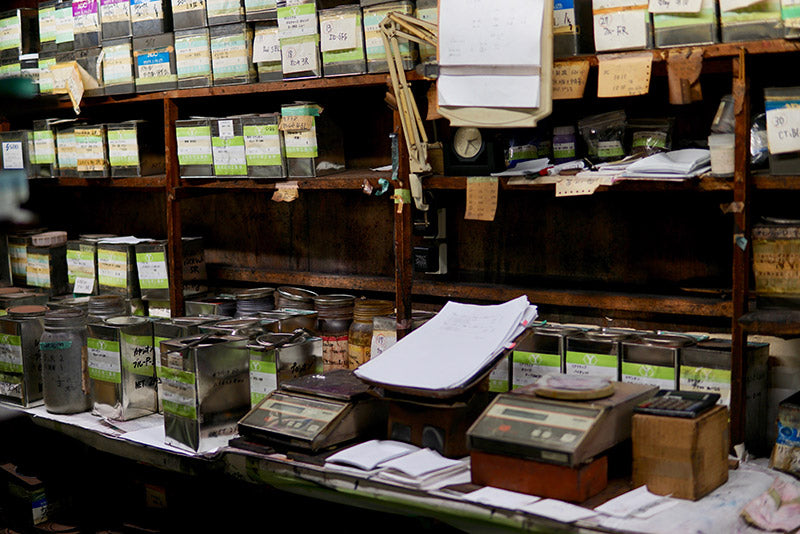Silk Screen Print Hachiman Senshoku in Kyoto シルクスクリーン、京都「八幡染色」さんを訪ねて
In the Southern area of Kyoto station, you can find some dye factories. This time, we had the pleasure to visit one of the famous dye companies in Kyoto, specialized in silk screen printing.
Mr. Yamaguchi is the owner of the company, HACHIMAN SENSHOKU.
His father started the company in 1939 in Kyoto.
ごきげんよう。いかがお過ごしですか?かなり夏らしくなってきましたね。
京都というと京都タワー側(東本願寺側)にいくことが多いと思いますが、八条口側(東寺が見える方)をさらに南にいくと着物関係の職人さんが多くいらっしゃいます。一昔前は、京都中に沢山いらしたんですけど。。(初めからシメっぽいっですが、気を取り直して・・・(笑)、今回は、京都での染色屋さんの一つに伺うことができましたのでご紹介させてください。
今回、うかがったのは、八幡染色有限会社さんで、社長の山口 泰成さんにご案内して頂きました。
この会社は、1939年(世界は第二次世界大戦に向かっている時代でした。また、マフィアのアル・カポネがアルカトラズ刑務所から釈放された年でもあります)に京都で山口さんのお父様が始められたんだそうです。

Yamaguchi, his younger brother and a couple of employees run the traditional dye house. He supplies for some famous brands.
The workshop and building has a feeling of the Showa time (retro 60s-70s) – as a lover of everything with a story and some age, this place was like heaven. Even though the building has aged, the working equipment seemed to have been taken care of well.
工場にはいると、気持ちは昭和時代初期(バブルへGO、ならぬ、昭和へGO)。この世界観は大好きです。建物はかなり年季が入っているのですが、そこで使われる道具、器具たちはとても丁寧にメンテされています。使われている機材は古く、もう壊れたらパーツを作っていないこともあるんだそうです。
現在、山口さんと弟さんと数人の職人さんで、八幡染色はまわっています。私の好きな有名な京都のブランドのお仕事もされてるんです。
建物は、まず、事務所部分がありまして、そこから工房につながっております。工房部分は、洗い場が付属したシルクスクリーンの作業場、色を作る「研究所(っぽい)」、色試験のため蒸す場所がありました。事務所の近くには出荷のため生地の倉庫がありました。
When entering the building, there is an office space and then the workshops mainly consisting of the silk screening area with a washing sink as well as an ink mixing lab and examination/steaming area. Close to the office we found a small warehouse of fabrics and the finished works being processed for delivery.
Mr. Yamaguchi kindly explained the silk screening process. During our visit, there were two persons silk screening. Everyone was so kind and took time to show us their work.
山口さんはシルクスクリーンの工程について丁寧にご説明して下さいました。訪問時は、二名の職人の方がシルクスクリーン作業をしておられました。お邪魔ムシの私たちにも拘らず、みなさんに親切に説明して頂き、作業を見せていただいちゃいました。


As you can see above, a multicolored design has to be printed several times with various screens to create the full pictures.
For example if you wanted to print a red flower you may need 3 screens: One for the green stem and leaf, one for the red flower petals and maybe another one to dye the background in another colour. A process which requires absolute precision and experience.
上の写真のような、様々な色彩のデザインは、幾度も異なるスクリーン(版)を用いて染色し、完成形となります。例えば、赤い花をプリントする場合、3つのスクリーンが必要になります。一つは、緑用の茎と葉っぱの部分、もう一つは、赤い花びらの部分、そして、背景部分を別の色でといった塩梅です。これには、相当な正確さと経験が求められます。

So many screens 版は無数にあります。 
The Blade 職人の刀 スケージ
Using the wooden blade with an attached rubber lip, the ink is transferred into the textile through the silk screen. Different dye works need different flexibility in rubber, hence the large selection.
The blades used for silk screen reminded me a little of samurai swords.
端にゴムのついた木の剣のような道具(スケージと呼びます)をつかい、染料を生地に刷り込みます。染料によって、端のゴムの柔らかさを使い分けます。スケージはまるでお侍さんの刀のようですよね。

Silk screen in progress 作業中のシルクスクリーン 
Viewing sample swatches 色サンプルを見せていただきました
So exciting to see the beautiful work up close.
見てください、この技!動画じゃなくても、分かりますよね!?笑
The silk screen table is actually as long as 25m. This takes quite a lot of arm grease to complete! (Also thinking of the many steps of drying and repeating with different screens.)
シルクスクリーンで用いる台は、約25メートル。この距離を行ったり来たり作業するのは並みの努力ではありません。異なる版で、何色も使うとなるとなおさらです。

Releasing the color paste 染料を流します! 
Solid color dye on top of design 染料を刷り込みます!

After dyeing is done, the screen and blades need to be washed at a washing station.
色を刷り込んだ後は、スクリーンとスケージを洗い場でキレイにします。大きな洗い場で、お水をじゃーじゃー使って洗う姿は壮観です。

After leaving the dye area, we got to peek into the ink lab. The beautiful colors are made here with the expertise of professionals. Does it remind you of a vintage pharmacy as well?
染色のエリアから、染料を調合する部屋、色の研究所を見せていただきました。長年の知識と勘で、美しい色が作られていきます。ちなみに、ここは古い薬局のような感じがしませんか?

Making exactly the same color is very difficult job. Mixing just the same amount of ink does not do the trick. Even though you do so, the outcome is often different due to many factors such as climate, humidity, fabric etc. It is hard especially to recreate a light color.
同じ色を再現するのはとても難しい技だそうです。というのも、同じ分量で同じ工程でつくった染料でも、その時の季節、湿度、温度など様々な要素に影響されます。特に淡い色の再現が難しいとおっしゃっておりました。

Buckets with mixed dye 調合された染料の入ったバケツ 
The “nori” paste 糊
The sticky pastes called “nori” are used be mixed with dye. It is made of sea weed. Kinda soft and squishy, haha.
糊は、染料と混ぜて使います。海草由来のもので、触ってみると、ナマもの感があります。やわらかくてちょっと気持ちい。

Small steamer next to laundry machines to test the color 洗濯機の横には、色を試すための小型の蒸し器があります 
Fabric swatches 色の見本
The younger brother of Mr. Yamaguchi joined us to explain his expertise of color mixing and steaming. So exciting to learn so much about the dyeing process and materials used.
山口さんの弟さんも染料の調合や蒸しの工程についてご説明して下さいました。染色の工程やどのように材料が使われるかについて学ばせていただきました。

After the factory visit, we had a small talk in the office over a cup of green tea.
Isn’t his office amazing? Almost looks like something in a Ghibli movie. It is a real craftsman’s office!
Possibly everyone would be overwhelmed by the big mountains of paper/documents, colour samples and textiles. It almost seems to represent the mountain of precious knowledge since its establishment.
We asked if he knows what and where everything is in his office. He says he knows basically where everything is. How amazing!!
工場見学の後、事務所に移動してお茶を頂きながらお話を伺いました。(ここには写っておりませんが、山口さんの奥様からおいしいお茶も頂いちゃいました。有難うございます!)
この事務所、超スキです。完全に、ジブリの世界観ですよね。これぞ、職人さんの事務所というイメージそのままです。ここに積み上げられた書類や色見本やサンプルに驚かれる方もいらっしゃると思いますが、これが創業からの努力、ノウハウの結晶なんだと思います。
「なにがどこにあるのか、分かるんですか?」という失礼な質問に、「基本的になにがどこにあるのか把握している」と笑顔でおっしゃっていました。

He told us the story about how the production shifted to overseas. He visited the silk screen factory in China in the past, as he explained to us with some photos taken from that trip. On his visit, he thought it would be 10 years to take over Japan’s silk screening. Now more than ten years passed.
Now many dye factories in Kyoto (and anywhere else in Japan) are gone and more apartments and parking lots sitting where they used to be.
No one is there to take over the company. Mr. Yamaguchi has 2 sons and both do not work in the dyeing industry. He joked that his sons get paid better than him. (Unfortunately that is probably true – the System in Japan does not treat craftsmen very well – our personal opinion).
山口さんは、染色はどんどん海外生産へ移った、とおっしゃります。以前、山口さんは中国の染色工場を訪問されたことがあったようです。その時の写真など見せていただきました。中国の工場の中で、こう思ったそうです、「あと十年は大丈夫」、と。そして、( わたしが会社を訪問した時点で、)「ちょうど今年で十年たった」と。ドラマチックですが、少し悲しい。今、周りをみても(京都も、日本全国)、多くの染物屋さんは廃業され、跡地は駐車場やマンションになってしまったようです。
会社の将来について、山口さんには、お二人の息子さんがいらっしゃいますが、別の畑でお仕事されており、この会社を継ぐことはないようです。「息子のほうが給料いい」と冗談まじりに話していらっしゃいました。ただ、それって、本当のことかも、と思います。
日本は職人さんの国ですが、職人さんが食べていけない国でもあると感じています(生意気言ってます 笑)。
Thank you so much for the precious chance to be in the factory and thank you and your staff for taking the time.
山口さんをはじめ、八幡染色有限会社の皆様、お話をして頂き、感謝です。今回にコリず、また、京都に行く際はお邪魔させて下さい。

Visiting Hachiman Senshoku, we felt so amazed by the work of dye. It is a pity this industry is shrinking in Japan. We are hoping the market will revive and flourish with new demands! We are a tiny fish in the market and do not think we can be any help but if any, please talk to them for great projects! (If any Japanese help needed, just talk to us!)
今回、 お伺いして感じたのは、染色のお仕事、職人芸、職人魂への尊敬です。日本で、この産業が縮小しているのは残念です。新たな需要により、またこの産業が息を吹き返せるんじゃないか、こんな小さな無力な自分でも、なにかできる事はないのか、と自問自答してしまいました。
この会社さんへのお仕事、是非、お声がけしてあげてください(結局、他力本願かい!w)。とてもよい方々です。
HACHIMAN SENSHOKU 八幡染色有限会社
Kyoto 京都
TEL: 075-691-6413
FAX: 075-681-3564
Thank you for reading!
今回の記事、いかがでしたか?もし、ここに行ったらいい、うちに来てほしい、などございましたら、ご連絡お待ちしてます! 書き方が悪いといった苦情もお受けしております 笑






































